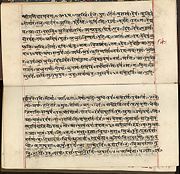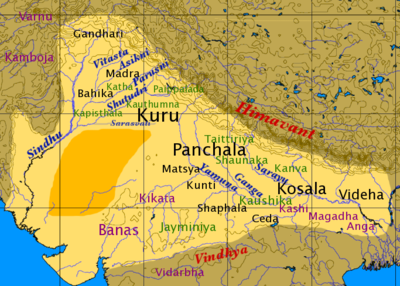The earliest evidence for elements of Hinduism date back to the late Neolithic to the early Harappan period (5500–2600BCE). Hinduism is the oldest and most complex of all religious systems. Providing an adequate history for the development of Hinduism is difficult, since it has no specific founder or theology and originated in the religious practices of Aryan tribes who moved to India from central Asia more than three thousand years ago. The Aryans attacked the Harappan people who lived in modern day India around 1500 BC. Eventually, through adaptation to the religious beliefs of the other, both groups developed similar religious belief systems, founded on the polytheism of the Aryans and the sanctity of fertility of the Harappans.
Soon, the predominantly Aryan society developed the caste system, which ranked society according to occupational class. The caste system is as follows:
Brahmins priests
Kshatriyas soldiers, king-warrior class
Vaishyas merchants, farmers, Sutras laborers, craftspeople
Harijahns "untouchables"- those thought to be descended from the Harappan aboriginal people-extremely poor and discriminated against
The higher a person's caste, the more that person is blessed with the benefits and luxuries life has to offer. Although the caste system was outlawed in 1948, it is still important to the Hindu people of India and is still recognized as the proper way to stratify society.
Since the early days of Hinduism, it has branched and now encompasses a wide variety of religious beliefs and religious organizations. Not only is it the primary religion of the region around India, but portions of Hindu beliefs have found their way across oceans to other countries and have been influential in the foundations of other religions, such as Transcendental Meditation and Buddhism.
The beliefs and practices of the pre-classical era (1500–500BCE) are called the "historical Vedic religion". Modern Hinduism grew out of the Vedas, the oldest of which is the Rigveda, dated to 1700–1100BCE. The Vedas center on worship of deities such as Indra, Varuna and Agni, and on the Soma ritual. They performed fire-sacrifices, called yajña and chanted Vedic mantras but did not build temples or iconsThe oldest Vedic traditions exhibit strong similarities to Zoroastrianism and with other Indo-European religions. During the Epic and Puranic periods, the earliest versions of the epic poems Ramayana and Mahabharata were written roughly from 500–100BCE, although these were orally transmitted for centuries prior to this period. The epics contain mythological stories about the rulers and wars of ancient India, and are interspersed with religious and philosophical treatises. The later Puranas recount tales about devas and devis, their interactions with humans and their battles against demons.
Three major movements underpinned the naisance of a new epoch of Hindu thought: the advents and spread of Upanishadic, Jaina, and Buddhist philosophico-religious thought throughout the broader Indian landmass. The Upanishads, Mahavira (founder of Jainism) and Buddha (founder of Buddhism) taught that to achieve moksha or nirvana, one did not have to accept the authority of the Vedas or the caste system. Buddha went a step further and claimed that the existence of a Self/soul or God was unnecessary. Buddhism and Jainism adapted elements of Hinduism into their beliefs. Buddhism (or at least Buddhistic Hinduism) peaked during the reign of Asoka the Great of the Mauryan Empire, who unified the Indian subcontinent in the 3rd century BCE. After 200CE, several schools of thought were formally codified in Indian philosophy, including Samkhya, Yoga, Nyaya, Vaisheshika, Purva-Mimamsa and Vedanta. Charvaka, the founder of an atheistic materialist school, came to the fore in North India in the sixth century BCE. Between 400BCE and 1000CE, Hinduism expanded at the expense of Buddhism.

Though Islam came to India in the early 7th century with the advent of Arab traders and the conquest of Sindh, it started to become a major religion during the later Muslim conquest in the Indian subcontinent. During this period Buddhism declined rapidly and many Hindus converted to Islam. Some Muslim rulers such as Aurangzeb destroyed Hindu temples and persecuted non-Muslims, while others, such as Akbar, were more tolerant. Hinduism underwent profound changes in large part due to the influence of the prominent teachers Ramanuja, Madhva, and Chaitanya. Followers of the Bhakti movement moved away from the abstract concept of Brahman, which the philosopher Adi Shankara consolidated a few centuries before, with emotional, passionate devotion towards the more accessible avatars, especially Krishna and Rama.
Indology as an academic discipline of studying Indian culture from a European perspective was established in the 19th century, led by scholars such as Max Müller and John Woodroffe. They brought Vedic, Puranic and Tantric literature and philosophy to Europe and the United States. At the same time, societies such as the Brahmo Samaj and the Theosophical Society attempted to reconcile and fuse Abrahamic and Dharmic philosophies, endeavouring to institute societal reform. This period saw the emergence of movements which, while highly innovative, were rooted in indigenous tradition. They were based on the personalities and teachings of individuals, as with Shri Ramakrishna and Ramana Maharshi. Prominent Hindu philosophers, including Sri Aurobindo and Swami Prabhupada (founder of ISKCON), translated, reformulated and presented Hinduism's foundational texts for contemporary audiences in new iterations, attracting followers and attention in India and abroad. Others such as Swami Vivekananda, Paramahansa Yogananda, B.K.S. Iyengar and Swami Rama have also been instrumental in raising the profiles of Yoga and Vedanta in the West.
References
McDowell, Josh and Don Stewart, Handbook of Today's Religions. Nashville: Thomas Nelson Publishers, 1983. Twelfth printing, June 1992.
Shelley, Fred M. and Audrey E. Clarke, eds. Human and Cultural Geography. Dubuque, Iowa: Wm. C. Brown Publishers, 1994.



